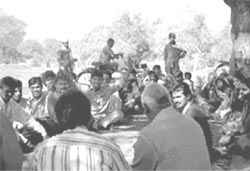Water revolution
 Much water has flown in the history of Madhya Pradesh's Dhar district. The legendary romance of Rani Rupmati and Bag Bahadur has found indelible expressions in numerous waterbodies of the district's fort town Mandu. Most of these traditional water harvesting structures were built by Bag Bahadur for his love Rupmati. The people during that time had a fascination for water.
Much water has flown in the history of Madhya Pradesh's Dhar district. The legendary romance of Rani Rupmati and Bag Bahadur has found indelible expressions in numerous waterbodies of the district's fort town Mandu. Most of these traditional water harvesting structures were built by Bag Bahadur for his love Rupmati. The people during that time had a fascination for water.
It seems the district is now reliving its fabled romance with water. As the state's week-long water conservation campaign, Pani Roko Abhiyan, started on February 3, some 2,400 people of the drought-affected villages of Pannala and Hemabardi took up water conservation activities. As one enters these villages, one can see handpumps, roof water-collecting funnels and filter tanks installed by the residents. From this, the water collected is diverted towards the tubewell for recharging. Mohini Shrivastav, a development officer, seeing a house's wastewater flowing across the road suggests, "Make a soak pit so that the water can get filtered and then go for recharge.' The villagers do it instantly.
Water conservation campaign is the theme of the state government's annual Gram Sampark Abhiyan, where the authorities meet the villagers to create a better atmosphere for governance. After the community based watershed movement under the Rajiv Gandhi Watershed Development Mission (rgwdm), the current campaign was to start a massive social movement for water conservation in all the 51,806 villages of the state. Water conservation has been given top priority in the state's agenda as it faces the second consecutive drought. "We plan to build many water harvesting structures in the next four months, but the important point is to sustain the whole movement,' says Manish Rastogi, director, rgwdm .
Though a statewide campaign, districts have been given the freedom to evolve their own strategy to create awareness. For each district, one official has been deputed to coordinate the campaign and at the village level, the watershed committees, formed under the rgwdm, spearhead it.
"From 240-280 kg per hectare (kg/ha) before the 2000 drought, crop yields have now come down to 120 kg/ha,' says C S Vhadwania, an agriculture development officer. So the villages started harvesting water. "This year there was no drinking water crisis,' says Bhawar Singh, a villager. A team of local residents and government officials spearheaded the Pani Roko Abhiyan. Villagers are deepening a tank at the far end of the village. This talab serves as a tank for the livestock of all the villages within its vicinity in this hour of drought.
Problem areas The movement has also served as an opportunity to assess the administrative lacuna. Jamnia, a village overlooking Mandu, is an example. Though it has taken up watershed activities under the rgdwm , the village could not participate in the Pani Roko Abhiyan. The project officer says that since the village has recently been declared a town panchayat, the campaign could not be taken up. This case shows that administrative glitches can stop a movement from reaching the village.
Even for the watershed mission, some officials doubt its sustainability. Says J Sharma of Sardarpur block: "The response for the Pani Roko Abhiyan has been good in non-watershed villages, but not for watershed villages. In a watershed village, the villagers know that it is another campaign, while in a non-watershed village, the villagers find it something new.' But participation largely depends on the ability to motivate.
Maurgaon is a micro-watershed village under the Sardarpur milli-watershed with a population of about 2,000. Being a watershed village, the villagers have developed a notion that the watershed committee governs all water works. They were not aware of the committee for the Pani Roko Abhiyan although they knew about the abhiyan . It is to be observed here that this may lead to confusion among the villagers about whom to approach for what purpose.
Says Rastogi: "To avoid confusion, in all watershed villages, the watershed committee is responsible for the Pani Roko Abhiyan. Under the abhiyan , they decided to channelise rainwater from the rooftop to pre-dug recharge trenches. "This will help in recharging our handpumps.'
Tribal quest In the tribal dominated district of Jhabua, the watershed mission has worked wonders
Related Content
- Indian agriculture towards 2030
- Increasing the benefits and sustainability of irrigation through integration of fisheries
- Adapt now: a global call for leadership on climate resilience
- Find solutions for challenges like climate change
- Report of the Committee on Doubling Farmers’ Income: Volume V- sustainability concerns in agriculture (Ashok Dalwai Committee)
- Over 100 years of India's urban revolution
